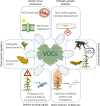Exploiting Plant Volatile Organic Compounds (VOCs) in Agriculture to Improve Sustainable Defense Strategies and Productivity of Crops
- PMID: 30941152
- PMCID: PMC6434774
- DOI: 10.3389/fpls.2019.00264
Exploiting Plant Volatile Organic Compounds (VOCs) in Agriculture to Improve Sustainable Defense Strategies and Productivity of Crops
Abstract
There is an urgent need for new sustainable solutions to support agriculture in facing current environmental challenges. In particular, intensification of productivity and food security needs require sustainable exploitation of natural resources and metabolites. Here, we bring the attention to the agronomic potential of volatile organic compounds (VOCs) emitted from leaves, as a natural and eco-friendly solution to defend plants from stresses and to enhance crop production. To date, application of VOCs is often limited to fight herbivores. Here we argue that potential applications of VOCs are much wider, as they can also protect from pathogens and environmental stresses. VOCs prime plant's defense mechanisms for an enhanced resistance/tolerance to the upcoming stress, quench reactive oxygen species (ROS), have potent antimicrobial as well as allelopathic effects, and might be important in regulating plant growth, development, and senescence through interactions with plant hormones. Current limits and drawbacks that may hamper the use of VOCs in open field are analyzed, and solutions for a better exploitation of VOCs in future sustainable agriculture are envisioned.
Keywords: abiotic and biotic stresses; defense priming; smart agriculture; sustainable crop production; volatile organic compounds.
Figures

References
-
- Aksenov A. A., Martini X., Zhao W., Stelinski L. L., Davis C. E. (2014). Synthetic blends of volatile, phytopathogen-induced odorants can be used to manipulate vector behavior. Front. Ecol. Evol. 2:78. 10.3389/fevo.2014.00078 - DOI
-
- Ameye M., Audenaert K., De Zutter N., Steppe K., Van Meulebroek L., Vanhaecke L., et al. . (2015). Priming of wheat with the green leaf volatile Z-3-hexenyl acetate enhances defense against Fusarium graminearum but boosts deoxynivalenol production. Plant Physiol. 167, 1671–1684. 10.1104/pp.15.00107, PMID: - DOI - PMC - PubMed
LinkOut - more resources
Full Text Sources
Other Literature Sources

